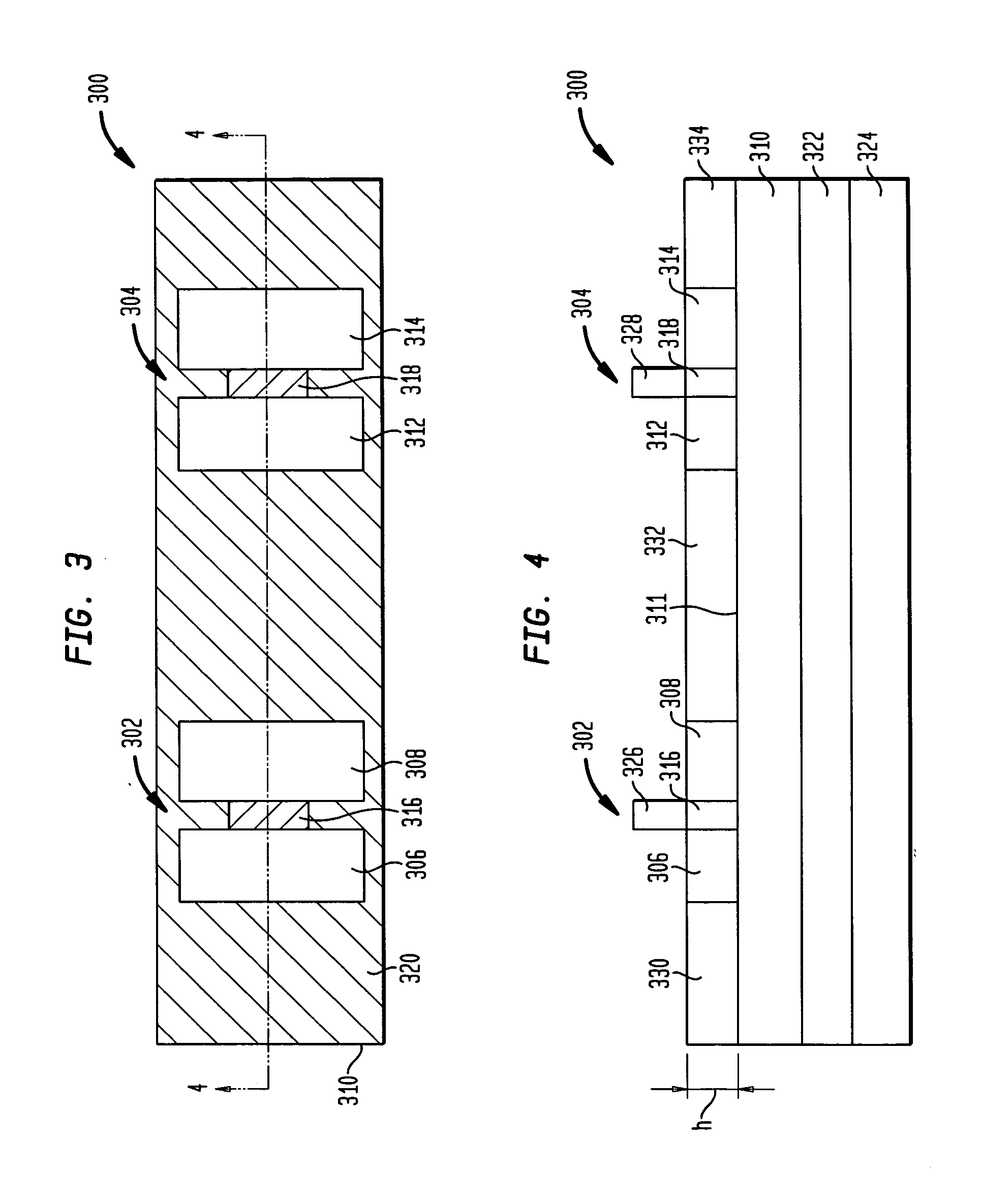Devices having patterned regions of polycrystalline organic semiconductors, and methods of making the same
a polycrystalline organic semiconductor and semiconductor technology, applied in thermoelectric devices, nanoinformatics, transportation and packaging, etc., can solve the problems of inability to meet the requirements of harsh conditions, inability to withstand the harsh conditions of ambient temperature, rigid and brittle inorganic semiconductors, etc., to inhibit the nucleation of aromatic semiconductors, promote or inhibit crystal nucleation, and inhibit the effect of aromatic semiconductor nucleation
- Summary
- Abstract
- Description
- Claims
- Application Information
AI Technical Summary
Benefits of technology
Problems solved by technology
Method used
Image
Examples
exemplary embodiment 100
[0029]FIG. 1 shows an exemplary embodiment 100 of two thin film transistors generally indicated at 102 and 104. Thin film transistor 102 comprises a source electrode 106 and a drain electrode 108 in a spaced apart arrangement on a dielectric layer 110. The source electrode 106 and drain electrode 108 are fabricated from a composition to which a thiol moiety can bond, such as a composition comprising gold, silver, platinum, palladium, copper, or alloys of such elements. Thin film transistor 104 comprises a source electrode 112 and a drain electrode 114 fabricated from the same materials in a spaced apart arrangement on dielectric layer 110. A surface of each of the source electrodes 106 and 112 and of the drain electrodes 108 and 114 is centrally provided with semiconductor crystal nucleation augmentation regions 116, 120, 118 and 122, respectively constituted by a coating composition comprising a compound having a thiol moiety the electrodes and an aromatic moiety positioned to inte...
exemplary embodiment 300
[0033]FIG. 3 shows an exemplary embodiment 300 of two thin film transistors generally indicated at 302 and 304. Thin film transistor 302 comprises a source electrode 306 and a drain electrode 308 in a spaced apart arrangement on a dielectric layer 310. Thin film transistor 304 comprises a source electrode 312 and a drain electrode 314 in a spaced apart arrangement on dielectric layer 310. Dielectric layer 310 is fabricated from a material comprising silicon, such as SiO2 or an alkyl siloxane. Siloxanes are compounds that have the general formula SiOR1R2R3, in which R1, R2, and R3 can each independently be selected from the group consisting of: Cl, —O—CH3, —O—CH2CH3, or R in which R is a hydrocarbon moiety such as an alkyl group for example. Background information regarding such dielectric layers is provided in Collet, J., et al., “High Anisotropic Conductivity in Organic Insulator / Semiconductor Monolayer Heterostructure,” Applied Physics Letters, Vol. 76, No. 10, pp. 1339-1341, Mar....
exemplary embodiment 500
[0040]FIG. 5 shows an exemplary embodiment 500 of two thin film transistors generally indicated at 502 and 504. Thin film transistor 502 comprises a source electrode 506 and a drain electrode 508 in a spaced apart arrangement on a semiconductor layer 510. Thin film transistor 504 comprises a source electrode 512 and a drain electrode 514 in a spaced apart arrangement on a semiconductor layer 516. Transistors 502 and 504 are supported by a dielectric layer 518 fabricated from a material comprising silicon, such as SiO2 or a siloxane.
[0041]FIG. 6 shows a cross-sectional view of the exemplary embodiment 500 of thin film transistors 502 and 504, taken on line 6-6 in FIG. 5. Source electrode 506 and drain electrode 508 of transistor 502 are on semiconductor layer 510. Source electrode 512 and drain electrode 514 of transistor 504 are on semiconductor layer 516. Semiconductor layer 510 is on semiconductor crystal nucleation augmentation region 520, such augmentation region constituted by ...
PUM
 Login to View More
Login to View More Abstract
Description
Claims
Application Information
 Login to View More
Login to View More - R&D
- Intellectual Property
- Life Sciences
- Materials
- Tech Scout
- Unparalleled Data Quality
- Higher Quality Content
- 60% Fewer Hallucinations
Browse by: Latest US Patents, China's latest patents, Technical Efficacy Thesaurus, Application Domain, Technology Topic, Popular Technical Reports.
© 2025 PatSnap. All rights reserved.Legal|Privacy policy|Modern Slavery Act Transparency Statement|Sitemap|About US| Contact US: help@patsnap.com



